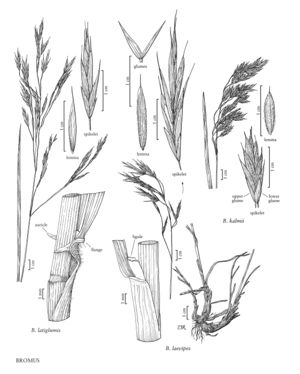Difference between pages "Author:Robertson, K.R." and "Bromus laevipes"
FNA>Volume Importer |
|||
| Line 1: | Line 1: | ||
| + | {{Treatment/ID | ||
| + | |accepted_name=Bromus laevipes | ||
| + | |accepted_authority=Shear | ||
| + | |publications= | ||
| + | |common_names=Chinook brome | ||
| + | |basionyms= | ||
| + | |synonyms= | ||
| + | |hierarchy=Poaceae;Poaceae subfam. Pooideae;Poaceae tribe Bromeae;Bromus;Bromus sect. Bromopsis;Bromus laevipes | ||
| + | |hierarchy_nav=<div class="higher-taxa"><div class="higher-taxon"><small>family</small>[[Poaceae]]</div><div class="higher-taxon"><small>subfamily</small>[[Poaceae subfam. Pooideae]]</div><div class="higher-taxon"><small>tribe</small>[[Poaceae tribe Bromeae]]</div><div class="higher-taxon"><small>genus</small>[[Bromus]]</div><div class="higher-taxon"><small>section</small>[[Bromus sect. Bromopsis]]</div><div class="higher-taxon"><small>species</small>[[Bromus laevipes]]</div></div> | ||
| + | |volume=Volume 24 | ||
| + | |mention_page= | ||
| + | |treatment_page=page 209 | ||
| + | }}<!-- | ||
| − | + | --><span class="statement" id="st-undefined" data-properties=""><b>Plants </b>perennial; not rhizomatous. <b>Culms</b> 50-150 cm, erect or basally decumbent, often rooting from the lower nodes; nodes 3-5(6), pubescent; internodes usually glabrous, often puberulent-pubescent just below the nodes, rarely puberulent throughout. <b>Sheaths</b> glabrous, sometimes slightly pubescent near the throat, sometimes with hairs in the auricular position; auricles absent or vestigial on the basal leaves; ligules 2-4.2 mm, glabrous, obtuse, lacerate; blades 13-26 cm long, 4-10 mm wide, light green or glaucous, flat, glabrous, sometimes scabrous on both surfaces. <b>Panicles</b> 10-20 cm, open, nodding; branches ascending to spreading, often drooping. <b>Spikelets</b> 23-35 mm, elliptic to lanceolate, terete to moderately laterally compressed, with 5-11 florets. <b>Glumes</b> glabrous, sometimes scabrous, margins often bronze-tinged; lower glumes 6-9 mm, 3-veined; upper glumes 8-12 mm, 5-veined; lemmas 12-16 mm, elliptic to lanceolate, rounded over the midvein, backs sparsely pilose, pubescent, or scabrous, margins densely pilose, at least on the lower 1/2, often bronze-tinged, apices acute to obtuse, entire, rarely slightly emarginate, lobes shorter than 1 mm; awns 4-6 mm, straight, arising less than 1.5 mm below the lemma apices; anthers 3.5-5 mm. <b>2n</b> = 14.</span><!-- | |
| − | + | ||
| − | + | -->{{Treatment/Body | |
| − | + | |distribution=Calif.;Oreg.;Nev.;Wash. | |
| + | |discussion=<p>Bromus laevipes grows from northern Oregon to southern California. It grows in shaded woodlands and on exposed brushy slopes, at 300-1500 m.</p> | ||
| + | |tables= | ||
| + | |references= | ||
| + | }}<!-- | ||
| + | |||
| + | --><!-- | ||
| + | |||
| + | -->{{#Taxon: | ||
| + | name=Bromus laevipes | ||
| + | |author= | ||
| + | |authority=Shear | ||
| + | |rank=species | ||
| + | |parent rank=section | ||
| + | |synonyms= | ||
| + | |basionyms= | ||
| + | |family=Poaceae | ||
| + | |distribution=Calif.;Oreg.;Nev.;Wash. | ||
| + | |reference=None | ||
| + | |publication title= | ||
| + | |publication year= | ||
| + | |special status= | ||
| + | |source xml=https://jpend@bitbucket.org/aafc-mbb/fna-data-curation.git/src/9216fc802291cd3df363fd52122300479582ede7/coarse_grained_fna_xml/V24/V24_291.xml | ||
| + | |subfamily=Poaceae subfam. Pooideae | ||
| + | |tribe=Poaceae tribe Bromeae | ||
| + | |genus=Bromus | ||
| + | |section=Bromus sect. Bromopsis | ||
| + | |species=Bromus laevipes | ||
| + | }}<!-- | ||
| + | |||
| + | -->[[Category:Treatment]][[Category:Bromus sect. Bromopsis]] | ||
Revision as of 03:19, 27 July 2019
Plants perennial; not rhizomatous. Culms 50-150 cm, erect or basally decumbent, often rooting from the lower nodes; nodes 3-5(6), pubescent; internodes usually glabrous, often puberulent-pubescent just below the nodes, rarely puberulent throughout. Sheaths glabrous, sometimes slightly pubescent near the throat, sometimes with hairs in the auricular position; auricles absent or vestigial on the basal leaves; ligules 2-4.2 mm, glabrous, obtuse, lacerate; blades 13-26 cm long, 4-10 mm wide, light green or glaucous, flat, glabrous, sometimes scabrous on both surfaces. Panicles 10-20 cm, open, nodding; branches ascending to spreading, often drooping. Spikelets 23-35 mm, elliptic to lanceolate, terete to moderately laterally compressed, with 5-11 florets. Glumes glabrous, sometimes scabrous, margins often bronze-tinged; lower glumes 6-9 mm, 3-veined; upper glumes 8-12 mm, 5-veined; lemmas 12-16 mm, elliptic to lanceolate, rounded over the midvein, backs sparsely pilose, pubescent, or scabrous, margins densely pilose, at least on the lower 1/2, often bronze-tinged, apices acute to obtuse, entire, rarely slightly emarginate, lobes shorter than 1 mm; awns 4-6 mm, straight, arising less than 1.5 mm below the lemma apices; anthers 3.5-5 mm. 2n = 14.
Distribution
Calif., Oreg., Nev., Wash.
Discussion
Bromus laevipes grows from northern Oregon to southern California. It grows in shaded woodlands and on exposed brushy slopes, at 300-1500 m.
Selected References
None.
